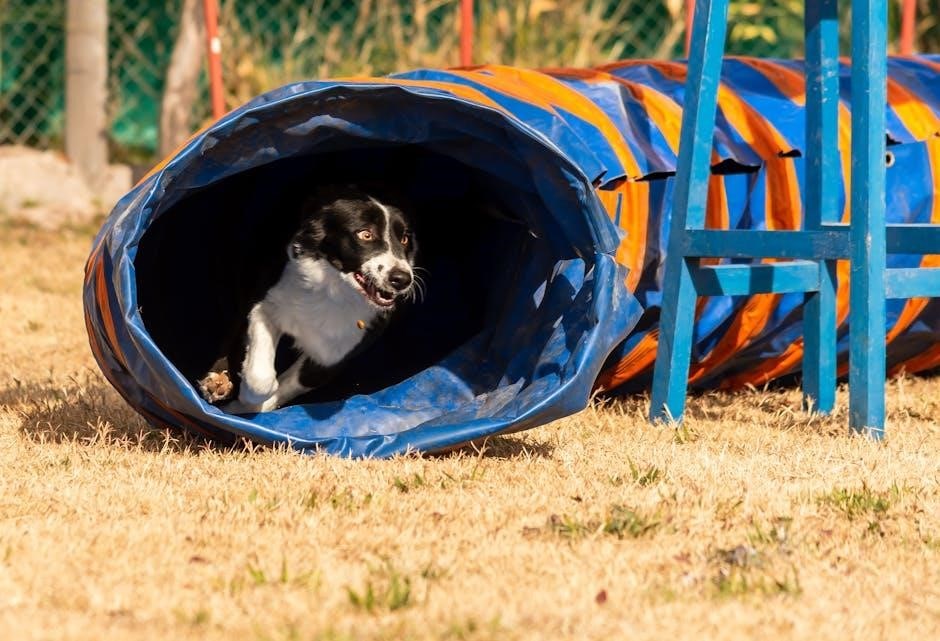Cubital Tunnel Syndrome (CTS) is a common condition where the ulnar nerve is compressed at the elbow, causing numbness, tingling, and weakness in the hand. Exercises play a crucial role in managing symptoms and promoting recovery.
1.1 Definition and Overview
Cubital Tunnel Syndrome (CubTS) is a condition where the ulnar nerve is compressed or irritated at the elbow, leading to numbness, tingling, and weakness in the hand. It occurs when the ulnar nerve, which runs through the cubital tunnel at the elbow, is stretched or compressed. This can result from prolonged elbow flexion, repetitive motions, or anatomical factors. Symptoms often affect the ring and little fingers, and if left untreated, may progress to muscle atrophy. Early diagnosis and conservative management, including specific exercises, are key to alleviating symptoms and preventing further complications;
1.2 Importance of Exercises in Management
Exercises are crucial in managing Cubital Tunnel Syndrome, as they help alleviate symptoms and prevent progression. Nerve gliding and stretching exercises can reduce pressure on the ulnar nerve, improving mobility and strength. These exercises promote nerve movement through the cubital tunnel, enhancing recovery. Consistent practice can delay or even avoid surgical intervention. Strengthening and flexibility routines also support long-term relief. A structured exercise program tailored to individual needs is essential for effective management and restoring functional ability.

Symptoms of Cubital Tunnel Syndrome
Numbness and tingling in the ring and little fingers, muscle weakness, and pain in the elbow and forearm are common symptoms of Cubital Tunnel Syndrome.
2.1 Numbness and Tingling in the Hand
Numbness and tingling in the hand, particularly in the ring and little fingers, are hallmark symptoms of Cubital Tunnel Syndrome. These sensations often worsen with prolonged elbow flexion or direct pressure on the ulnar nerve. Patients may experience intermittent or constant discomfort, especially when bending the elbow or leaning on the affected side. Such symptoms can interfere with daily activities and fine motor tasks. Early recognition and intervention, including targeted exercises, are essential to alleviate discomfort and prevent further nerve irritation or damage.
2.2 Muscle Weakness and Atrophy
Muscle weakness and atrophy are common in advanced cases of Cubital Tunnel Syndrome, particularly in the hand and forearm. Prolonged ulnar nerve compression can lead to reduced grip strength and difficulty with fine motor tasks. Over time, muscle wasting may occur, especially in the intrinsic muscles of the hand. Early intervention, including exercises and activity modification, is crucial to prevent irreversible damage. If severe atrophy or clawing of the fingers develops, prompt referral to a hand surgeon is recommended to address nerve compression effectively.
2.3 Pain in the Elbow and Forearm
Pain in the elbow and forearm is a frequent symptom of Cubital Tunnel Syndrome, often worsening with activities like bending the elbow or leaning on the affected area. The ulnar nerve’s compression can cause aching or tenderness, particularly along the inner elbow and forearm. Prolonged nerve irritation may lead to radiating discomfort. Activities such as bicycling or repetitive gripping can exacerbate pain due to nerve inflammation. Early intervention, including rest and exercises, is essential to alleviate discomfort and prevent further nerve damage.

Causes and Risk Factors
Cubital Tunnel Syndrome is caused by prolonged elbow flexion, repetitive motions, and leaning on the elbow, often exacerbated by nerve inflammation from activities like bicycling.
3.1 Prolonged Elbow Flexion
Prolonged elbow flexion is a primary contributor to cubital tunnel syndrome, as it compresses the ulnar nerve. Activities involving sustained bending, such as leaning on elbows or repetitive motions, exacerbate nerve irritation. This compression leads to numbness and tingling in the hand, particularly in the ring and little fingers. Avoiding prolonged elbow flexion and incorporating regular breaks can help reduce pressure on the ulnar nerve, preventing further discomfort and promoting recovery.
3.2 Repetitive Motion and Activities
Repetitive motion, such as frequent elbow bending or wrist movements, can irritate the ulnar nerve, leading to cubital tunnel syndrome. Activities like cycling, typing, or gripping tools for extended periods increase the risk. These motions strain the nerve, causing inflammation and compression. Over time, this can result in numbness, tingling, and weakness in the hand. Modifying repetitive tasks and incorporating regular breaks can help reduce nerve irritation and prevent progression of symptoms.
3.3 Anatomical Factors
Anatomical factors, such as a narrow cubital tunnel or instability of the ulnar nerve, can predispose individuals to cubital tunnel syndrome. The tunnel’s shape and tight ligaments may compress the nerve, especially during elbow flexion. Additionally, variations in the nerve’s path or nearby muscle structures can increase pressure on the ulnar nerve. These structural factors make the nerve more susceptible to irritation and compression, leading to symptoms like numbness and tingling in the hand and fingers.
3.4 Health Conditions Contributing to Cubital Tunnel Syndrome
Certain health conditions can increase the risk of developing cubital tunnel syndrome. These include diabetes, which can cause nerve damage, and rheumatoid arthritis, which may lead to inflammation around the elbow. Additionally, conditions like obesity or previous elbow injuries can contribute by altering the anatomical structure or increasing pressure on the ulnar nerve. Managing these underlying health issues is crucial for effective symptom relief and prevention of further nerve compression.
Diagnosis of Cubital Tunnel Syndrome
Diagnosis involves physical exams to assess nerve function, nerve conduction studies to measure nerve speed and strength, and imaging techniques to identify structural issues.
4.1 Physical Examination
A physical exam assesses nerve function, muscle strength, and areas of tenderness. The Tinel’s sign test involves tapping the ulnar nerve at the elbow to check for numbness or tingling. Physicians also evaluate hand grip strength and look for signs of muscle atrophy or clawing in the fingers. Range of motion tests for the elbow and wrist are performed to identify limitations or pain. These assessments help confirm the diagnosis and guide further testing or treatment plans tailored to the patient’s condition.
4.2 Nerve Conduction Studies
Nerve conduction studies (NCS) are essential for diagnosing cubital tunnel syndrome. These tests measure the speed and strength of electrical signals in the ulnar nerve. By comparing nerve function in affected and healthy areas, NCS helps confirm nerve compression. Electrodes are placed on the skin to record nerve responses, providing objective data on nerve damage. Abnormal results, such as slowed nerve conduction velocity, indicate ulnar nerve impairment. This diagnostic tool is critical for assessing the severity of nerve involvement and guiding appropriate treatment strategies.
4.3 Imaging Techniques
Imaging techniques, such as MRI or ultrasound, are vital for confirming cubital tunnel syndrome. These methods provide detailed images of the ulnar nerve and surrounding structures. MRI can reveal nerve compression, swelling, or displacement, while ultrasound offers a non-invasive way to assess nerve mobility and inflammation. Imaging helps identify structural abnormalities, such as nerve subluxation or cubital tunnel narrowing. While clinical exams and nerve studies are often sufficient, imaging is useful for complex cases or when surgery is considered. It aids in confirming the diagnosis and guiding treatment decisions.

Treatment Options
Treatment for cubital tunnel syndrome often involves conservative management, including exercises, activity modification, and ergonomic adjustments. Surgery may be considered if symptoms persist despite non-surgical interventions.

5.1 Conservative Management
Conservative management for cubital tunnel syndrome focuses on reducing symptoms through non-invasive methods. This includes ulnar nerve gliding exercises, stretching, and ergonomic adjustments to avoid prolonged elbow flexion. Activity modification, such as avoiding repetitive motions, is also recommended. Bracing or splinting the elbow in a neutral position can alleviate pressure on the ulnar nerve. Additionally, anti-inflammatory medications may be prescribed to reduce swelling. These approaches aim to relieve compression and restore nerve function, often preventing the need for surgical intervention. Regular exercise and proper posture are key to managing symptoms effectively.
5.2 Surgical Intervention
Surgical intervention for cubital tunnel syndrome is considered when conservative treatments fail to alleviate symptoms. The primary goal is to decompress the ulnar nerve by releasing tight tissues or restructuring the cubital tunnel. Procedures may include nerve decompression or transposition of the ulnar nerve to a more stable position. Surgery is typically recommended for severe cases with significant muscle atrophy or persistent numbness and tingling. Recovery involves physical therapy to restore strength and mobility. Surgery can provide long-term relief for patients who do not respond to non-invasive treatments.

Role of Physical Therapy
Physical therapy plays a vital role in managing cubital tunnel syndrome by improving nerve mobility and reducing symptoms through targeted exercises like ulnar nerve gliding and stretching.
6.1 Goals of Rehabilitation
The primary goals of rehabilitation for cubital tunnel syndrome include alleviating numbness, tingling, and pain, restoring normal nerve function, and improving hand and elbow mobility. Exercises aim to enhance ulnar nerve gliding, reduce compression, and strengthen forearm muscles. Rehabilitation also focuses on preventing further nerve damage and promoting long-term recovery. A structured program combining nerve gliding, stretching, and strengthening exercises helps restore functional abilities and reduces the risk of recurrence. Consistency in performing these exercises is key to achieving optimal outcomes and regaining normal hand and elbow function.
6.2 Exercise Progression
Exercise progression for cubital tunnel syndrome involves advancing from gentle nerve gliding to more dynamic movements. Initially, focus on pain-free ulnar nerve gliding exercises to improve mobility. Gradually incorporate stretching exercises for the elbow, wrist, and forearm to enhance flexibility. Strengthening exercises, such as grip and forearm strengthening, are introduced to restore muscle function. The intensity and duration of exercises are increased as symptoms improve. Consistency and proper form are crucial to avoid aggravating the condition. Progression should be tailored to individual tolerance and monitored for any signs of discomfort or regression.

Ulnar Nerve Gliding Exercises
Ulnar nerve gliding exercises help relieve compression by promoting nerve mobility. Start with arm extended, palm up, then bend elbow, rotate palm outward, and point fingers toward your shoulder.
7.1 Step-by-Step Guide
Start with your arm extended, palm facing up.
Slowly bend your elbow, bringing your hand toward your shoulder.
Rotate your palm outward and bend your wrist so fingers point toward your shoulder.
Hold for 5 seconds, then gently return to the starting position.
Repeat 10-15 times, 2-3 sets daily.
This exercise helps glide the ulnar nerve through the cubital tunnel, reducing compression and improving mobility.
7.2 Frequency and Duration
Perform ulnar nerve gliding exercises 2-3 times daily, completing 10-15 repetitions per session. Start with gentle movements and gradually increase intensity as comfort allows. Each exercise should be done in a slow, rhythmic manner to avoid discomfort. Aim for 5-10 minute sessions, focusing on smooth, controlled motions. Consistency is key to improving nerve mobility and reducing symptoms. Over time, as symptoms improve, the frequency can be adjusted, but regular practice is essential for long-term relief and prevention of recurrence.
Stretching Exercises
Stretching exercises are essential for relieving tension in the elbow and forearm. Focus on elbow flexion/extension and wrist stretches to improve mobility and reduce discomfort.
8.1 Elbow Flexion/Extension Stretch
Start with your arm extended and palm up. Slowly bend your elbow, bringing your hand toward your shoulder, and hold for 20-30 seconds. Gently straighten your arm again. Repeat 3-5 times. This stretch targets the ulnar nerve, relieving tension and improving mobility. Perform this exercise in a controlled manner to avoid discomfort. Regular practice helps reduce stiffness and enhances flexibility in the elbow joint, essential for managing cubital tunnel syndrome symptoms effectively.
8.2 Wrist and Forearm Stretches
Begin by extending your arm in front of you with your palm down. Use your opposite hand to gently pull your wrist back, stretching your forearm. Hold for 20-30 seconds and repeat 3-5 times. Next, turn your palm upward and repeat the stretch. This exercise targets the forearm muscles and wrist flexors, reducing tension and improving flexibility. Regular practice helps alleviate stiffness and enhances blood flow to the affected area, supporting recovery from cubital tunnel syndrome. Perform these stretches slowly and avoid bouncing to maximize effectiveness.
Strengthening Exercises
Strengthening exercises focus on improving grip strength and forearm muscle endurance, essential for reducing strain and supporting recovery from cubital tunnel syndrome.
9.1 Grip Strengthening
Grip strengthening exercises are essential for improving hand function and reducing symptoms of cubital tunnel syndrome. Using a stress ball or hand gripper, squeeze gently for 5-10 seconds, then release. Repeat 10-15 times. This helps enhance dexterity and reduces strain on the ulnar nerve. Consistent practice can improve overall hand strength, making daily activities easier. Incorporate grip exercises into your routine to support recovery and prevent further nerve irritation.
9.2 Forearm Strengthening
Forearm strengthening exercises are vital for reducing strain on the ulnar nerve and improving overall arm function. Wrist extensions, where you lift light weights with your palm down, and forearm rolls using a light weight or resistance band, are effective. These exercises help build muscle endurance and reduce nerve compression. Perform 3 sets of 10-12 repetitions daily. Consistent practice can enhance forearm strength, reducing symptoms and supporting long-term recovery from cubital tunnel syndrome.
Ergonomic Adjustments
Ergonomic adjustments are crucial for managing cubital tunnel syndrome. Ensure proper workstation setup, avoid prolonged elbow flexion, and use tools with cushioned handles to reduce nerve compression.
10.1 Workspace Setup
Proper workspace setup is essential for managing cubital tunnel syndrome. Ensure your chair height allows elbows to rest at 90 degrees with wrists straight. Use ergonomic equipment like wrist rests for keyboards and cushioned handles for tools. Avoid leaning on elbows for extended periods and keep the workspace clutter-free to prevent nerve compression. Adjust monitor height to avoid neck strain, which can indirectly affect elbow posture. Regularly assess and modify your setup to promote comfort and reduce strain on the ulnar nerve.
10.2 Activity Modification
Modifying activities is crucial to alleviate cubital tunnel syndrome symptoms. Avoid prolonged elbow flexion or repetitive motions that strain the ulnar nerve; Take regular breaks during tasks involving elbow bending or gripping. Replace high-risk activities with low-impact alternatives, such as swimming or cycling, to reduce nerve irritation. Incorporate nerve gliding exercises into daily routines to improve mobility and strength. Avoid leaning on elbows or using vibrating tools for extended periods. By adjusting daily activities, individuals can reduce pressure on the ulnar nerve and promote recovery.

Nerve Flossing Techniques
Nerve flossing techniques involve gentle exercises that relieve ulnar nerve compression by improving mobility and reducing inflammation. Regular practice enhances nerve gliding and alleviates symptoms effectively for cubital tunnel syndrome.
11.1 Ulnar Nerve Flossing
Ulnar nerve flossing is a technique to relieve compression by improving nerve mobility. Start with your arm extended, palm up. Bend your elbow, rotate your palm outward, and point fingers toward you. This gentle stretch helps reduce pressure on the ulnar nerve. Perform 10-15 repetitions, 2-3 times daily. Regular practice enhances nerve gliding, alleviates numbness, and strengthens forearm muscles. It is essential to maintain slow, controlled movements to avoid further irritation. This exercise is a cornerstone in managing cubital tunnel syndrome effectively.
11.2 Combining with Stretching
Combining ulnar nerve flossing with stretching exercises enhances relief from cubital tunnel syndrome symptoms. Start with nerve flossing, then transition into stretches like elbow flexion/extension or wrist extensions. This sequence improves nerve mobility and reduces muscle tightness. Perform stretches 2-3 times daily, holding each for 20-30 seconds. Regular practice improves nerve gliding, reduces numbness, and strengthens forearm muscles. Always maintain slow, controlled movements to avoid irritation. This combined approach is highly effective for managing symptoms and promoting long-term recovery.

Home Exercise Program
A daily routine of nerve gliding, stretching, and strengthening exercises is essential for managing cubital tunnel syndrome. Consistency and proper technique ensure optimal recovery and symptom relief.
12.1 Daily Routine
A structured daily routine is vital for managing cubital tunnel syndrome. Begin with gentle ulnar nerve gliding exercises to improve nerve mobility. Perform 10-15 repetitions of elbow flexion/extension stretches to reduce stiffness. Incorporate wrist and forearm stretches to alleviate tension. Strengthening exercises, such as grip strengthening and forearm resistance, should be done 2-3 times daily. End with nerve flossing techniques to promote nerve health. Consistency is key to preventing symptom progression and enhancing recovery. Adjust the routine based on individual progress and discomfort levels.
12.2 Progression of Exercises
Exercise progression for cubital tunnel syndrome should be gradual and tailored to individual tolerance. Start with gentle ulnar nerve gliding exercises and gradually increase intensity. As symptoms improve, incorporate strengthening routines like grip and forearm exercises. Stretching exercises, such as elbow flexion/extension and wrist stretches, should be advanced as mobility improves. Progression should focus on reducing discomfort while enhancing strength and flexibility. Always monitor symptoms and adjust the routine to avoid aggravation. Consistency and patience are key to achieving long-term relief and preventing recurrence.

When to Seek Medical Attention
Seek medical attention if symptoms like numbness, tingling, or muscle weakness worsen or persist despite exercises. Consult a specialist if severe pain or clawing occurs.
13.1 Severe Symptoms
Severe symptoms of cubital tunnel syndrome include persistent numbness, tingling, and muscle weakness in the hand or fingers. Clawing of the fingers or noticeable muscle atrophy may develop. If these symptoms worsen or are accompanied by intense pain, immediate medical evaluation is essential. Early intervention can prevent permanent nerve damage or the need for surgical intervention. Consulting a healthcare professional or hand surgeon is crucial to address severe cases effectively and restore normal function.
13.2 Lack of Improvement
If symptoms persist despite consistent exercise and conservative management, it is crucial to seek medical attention. Lack of improvement may indicate the need for further evaluation or alternative treatments. Severe cases, such as significant muscle atrophy or clawing of the fingers, require prompt referral to a hand surgeon. Persistent numbness, tingling, or weakness that does not respond to therapy may necessitate surgical intervention to relieve nerve compression and restore function. Early consultation with a specialist can prevent further deterioration and improve outcomes.
Preventing Recurrence
Preventing cubital tunnel syndrome recurrence involves maintaining a healthy lifestyle, avoiding prolonged elbow flexion, and incorporating regular exercises to strengthen and stretch the forearm and hand muscles.
14.1 Lifestyle Modifications
Lifestyle modifications are essential for preventing cubital tunnel syndrome recurrence; Avoid prolonged elbow flexion, especially during sleep or work. Maintain a healthy weight to reduce pressure on the ulnar nerve. Incorporate ergonomic adjustments in daily activities and workspace setup to minimize strain. Avoid smoking, as it impairs blood flow and nerve health. Regularly stretch and move to prevent stiffness. Modify repetitive activities that involve elbow bending or leaning. These changes, combined with consistent exercise, can significantly reduce the risk of recurrence and promote long-term nerve health.
14.2 Regular Exercise Maintenance
Regular exercise maintenance is vital for preventing cubital tunnel syndrome recurrence. Incorporate daily routines that include nerve gliding, stretching, and strengthening exercises. Focus on activities that improve ulnar nerve mobility and forearm flexibility. Consistency in exercise helps maintain muscle balance and reduces nerve compression risk. Gradually progress exercises to avoid overstrain while ensuring long-term benefits. Regular physical activity strengthens the muscles around the elbow, promoting stability and reducing the likelihood of nerve irritation. This proactive approach supports overall joint health and nerve function, aiding in sustained recovery and prevention.
Consistent practice of ulnar nerve gliding, stretching, and strengthening exercises is essential for managing cubital tunnel syndrome and achieving long-term relief from symptoms.
15.1 Summary of Key Points
Cubital tunnel syndrome is effectively managed through targeted exercises, including ulnar nerve gliding, stretching, and strengthening routines. These exercises help alleviate numbness, tingling, and weakness. Ergonomic adjustments and activity modifications are crucial for preventing recurrence. Consistent practice of these exercises, along with proper posture and avoiding prolonged elbow flexion, promotes long-term relief and functional recovery. Regular physical therapy and patient adherence to home exercise programs are essential for optimal outcomes and maintaining hand function.
15.2 Encouragement for Consistent Practice
Consistent practice of cubital tunnel exercises is vital for achieving lasting relief and preventing recurrence. Commitment to daily routines, even when symptoms improve, ensures sustained nerve health. Incorporate exercises into your lifestyle, such as during breaks or before activities. Celebrate small progress and stay motivated by tracking improvements. Remember, regular practice strengthens your hand and forearm, reducing the risk of future complications. Stay dedicated to your exercise program for long-term comfort and functionality;
